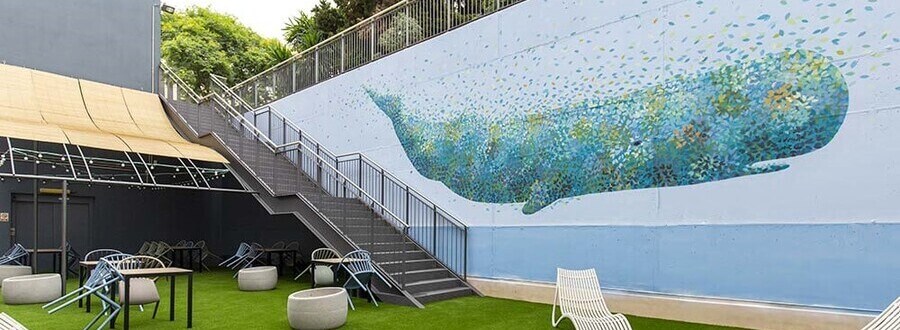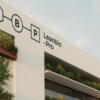
A sperm whale in the Park
Sperm Whale, by Christophe Deluz, a mural exhibited in the PCBeach -the Barcelona Science Park’s new leisure area– is one of the Park’s latest project to promote interaction between art and science through the decoration of its most iconic spaces and by giving contemporary artistic talents exposure and a projection.
In the spring of 2020, as the artistic community lamented the precarious situation spawned by the COVID-19 crisis, the Barcelona Science Park launched a competition –worth €5,000 to the winner– to create a design chosen freely by the participating artists for one of the outdoor patios that connects the buildings: the PCBeach. The idea was to create a leisure area where people could get away from their day-to-day routines and to encourage community members to socialise, eat or simply chill out.
The competition, which attracted eighteen artists, was won by Christophe Deluz, with his Sperm Whale work, a 4.5-m-high and 6.5-m-wide mural. The highly dynamic composition of a large whale floating on a blue backdrop, which represents the ocean, was conceived to whisk visitors off to a beach at the end of Barcelona’s Avenida Diagonal.
According to the artist, “Sperm Whale is meant to symbolise current concerns, such as protecting the environment, wildlife conservation and looking after the planet, since the sperm whale is a highly-endangered species threatened by the action of humankind and by the chemical and noise pollution affecting our seas and oceans”.
Deluz is a graphic and textile designer who holds a degree in Visual Communication from the École de Recherche Graphique (School of Graphic Research) of Brussels and has worked for several multinational companies. He is the artist behind several murals in Barcelona. The award panel members included Àlex Susanna, art director of the Vila-Casas Foundation, and Sergio Vila-Sanjuán, cultural journalist, writer and newly crowned winner of the National Cultural Journalism Award.
“We will continue to invest, more than ever, to make the Park a living ecosystem, an innovative and enriching space where people can come together and buildings, art, science and people can all interact. We already feature seven pieces by contemporary talents of the stature of Nuria Mora, Anna Taratiel, Kelly Arrontes or Bemie, and we are working to provide exposure to the creative language of other artists through further exhibits soon”, said Maria Terrades, Director of the Barcelona Science Park.
During March 2021, different artistic interventions were also completed in the Park’s coffee corners, meeting points to the PCB Community in the Cluster II building. With these spaces, the Park aims to provide spots for its community to rest, read or take a break. So far, four coffee corners have been decorated with different artistic interventions. The spaces pay tribute to the home countries of the Park’s four largest foreign communities: India, France, Italy and Germany. The spaces have a large vinyl map of a city from the country, designed by Canadian artist Jazzberry Blue, and an illustration by a local artist Giulia Neri (Italy), Eric Puybaret (France) and Ayeshe Sadr & Ishaan Dasgput (India).
Dialogues between art and science
Sperm Whale, by Christophe Deluz, and the different interventions in the Park’s coffee corners are the latest, but not the only, bets of the Barcelona Science Park to promote the intersection between art, science and technology, in a common territory that generates transversal and innovative connections.
The Parking of the Barcelona Science Park, officially opened at the end of 2010, was the space chosen by the Park to kick off its initiative to nurture interaction between art and science. The work, a 900-m long artistic mural by Bombardearte, is an epoxy-coated spray composition that adorns the walls around the car park, leveraging colour and recessed lighting as expressive resources and featuring scenes related to the institution’s activity that afford it character and personality.
In 2012, KOgraffx decorated more than 400 metres of the access ramps to the R&D&I Towers, connecting the Dr Gregorio Marañon Avenue and the Torres i Clúster buildings. The abstract motifs mimic cells and tiny organisms, and the polygonal mesh surrounding the entire structure reinforces the concept of cellular organisation.
In 2014, the Park’s Garden, a leisure space for the PCB Community was opened, in which Nuria Mora recreates a plastic proposal that plays with the space’s geometry and its furniture and fittings, combining the simplicity of abstract forms and flat volumes with a colour palette custom-designed by the painter.
In 2015, Anna Taratiel, one of the most outstanding representatives of the street-art global movement, culminated her artistic intervention in the main corridor that connects the Clúster I and Clúster II buildings, a pictorial and avant-garde composition more than 80 meters long, featuring high visual-impact geometric shapes that play with colour saturation to deliver unprecedented 2-D and 3-D perspectives.
In 2018, the artist Kelly Arrontes, a member of the ONCE, completed her first intervention in the Park, “Water is life”, a wall painting more than 125 meters long that embellishes the inner corridor that connects the Clúster I and Clúster II buildings. The work, true to the artist’s abstract expressionist style, is based on water: the mural’s four parts represent the symbiosis between its different physicochemical states and the artist’s own, according to the fluctuations of her visual acuity.
One year later, in February 2019, the painter unveiled “The Origin of Life” another mural work more than 125 meters long that decorates the walls of the corridor on Floor 0 that connects the PCB’s Clúster I and Cluster II buildings. Neurons and eye cells are the leitmotiv of this acrylic-based composition, which fuses paint with texture and reliefs on tissue paper.
In January 2021 a mural was made on the side wall of the Hèlix building. This work has been promoted by the Wallspot platform through an artistic professionalization program, which in this edition has wanted to give visibility to the essential tasks carried out by the Park and its community. The mural, under the theme of the nano universe, offers a magnifying view of everything microscopic that makes up the human body. The urban artist Bemie, through the cultural entity Rebobinart, has wanted to bring the area of such essential scientific research closer to the population through art, showing it in an accessible and understandable way.
• “Artistic interventions in the Barcelona Science Park” [pdf]




